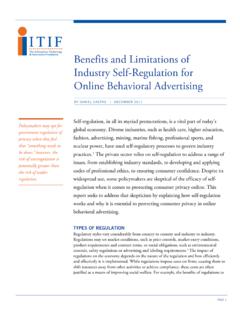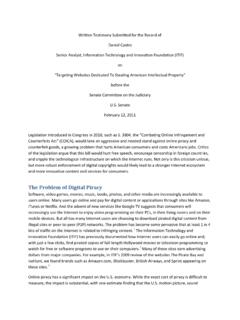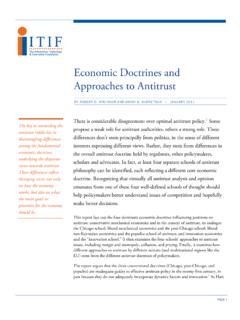Transcription of The Case for a National Manufacturing Strategy - ITIF
1 The Case for a National Manufacturing Strategy BY STEPHEN J. EZELL AND ROBERT D. ATKINSON. APRIL 2011. TABLE OF CONTENTS. Executive Summary .. 2. Introduction .. 4. Why is Manufacturing Important? .. 8. Manufacturing in Transition and Relative Decline .. 17. Why the united states Needs a National Manufacturing Strategy .. 24. What Would a National Manufacturing Strategy Do? .. 29. Conclusion .. 32. Appendix .. 34. Endnotes .. 35. Acknowledgments .. 40. THE INFORMATION TECHNOLOG Y & INNOVATION FOUNDATION | APRIL 2011 PAGE 1. EXECUTIVE SUMMARY. This paper builds the intellectual case for why the united states needs a serious National Manufacturing Strategy . The paper focuses on three key questions where to date consensus has been lacking: 1. Does the united states need a healthy Manufacturing sector? 2. How healthy is Manufacturing at the moment and for the foreseeable future?
2 3. Does the united states need a National Manufacturing Strategy ? Until there is a consensus that Manufacturing is important, that it is not healthy, and that a National Manufacturing policy is needed, it will be difficult to create a platform for reframing the conversation. Meanwhile, other nations are putting in place Manufacturing strategies that include key components such as tax incentives and large investments in research, skills development, infrastructure, and technology transfer and technical assistance. Every day we do nothing we risk falling further behind. The paper is divided into four major sections: 1) Why is Manufacturing Important? Manufacturing plays a critical role in the economy for five key reasons: 1. It will be extremely difficult for the united states to balance its trade account without a healthy Manufacturing sector. 2. Manufacturing is a key driver of overall job growth and an important source of middle-class jobs for individuals at many skill levels.
3 3. Manufacturing is vital to National security. 4. Manufacturing is the principal source of R&D and innovation activity. 5. The Manufacturing and services sectors are inseparable and complementary. 2) Manufacturing in Transition and Relative Decline Many who argue against a National Manufacturing Strategy do so because they claim that Manufacturing is quite healthy and that any job losses are due to superior productivity performance; 1 or they assert that Manufacturing is in decline everywhere, such that relative decline in Manufacturing is not a particularly noteworthy concern. This section rebuts both those mistaken perspectives, arguing that: 1. Output growth in Manufacturing sectors is overstated and, when measured properly, job loss in Manufacturing is a reflection also of output decline, not just of productivity increases. 2. Manufacturing decline is neither inevitable nor normal as demonstrated by the fact that Manufacturing is growing in many nations, including developed nations.
4 THE INFORMATION TECHNOLOG Y & INNOVATION FOUNDATION | APRIL 2011 PAGE 2. 3) Why the united states Needs a National Manufacturing Strategy Beyond the importance of a robust Manufacturing sector to economic health, there are three primary reasons why the united states needs a National Manufacturing Strategy : 1. Other countries have strategies to support their manufacturers and by lacking similar strategies we are therefore forcing our manufacturers to compete at a disadvantage. 2. Systemic market failures mean that absent Manufacturing policies, Manufacturing will underperform in terms of innovation, productivity, job growth, and trade performance. 3. If a country loses complex, high-value-added Manufacturing sectors, it's unlikely to get them back, even if the dollar were to decline dramatically. 4) What Would a National Manufacturing Strategy Do? It's important to understand that a considerable part of the loss in Manufacturing jobs has not just been a story of higher productivity leading to fewer jobs as was the case with the transformation of the agricultural sector over the last century.
5 It's been more a story of decline in output due to a loss of international competitiveness. This is why the decline of Manufacturing merits a serious policy response. To call for a Manufacturing Strategy is not to call for the same kind of sectoral or occupational composition in Manufacturing that the united states had twenty or fifty years ago. It's not to nostalgically wish for the re-creation of all the lost jobs from factories employing low-skill workers and producing commoditized products. Obviously the profile of Manufacturing evolves over time, just as the economy evolves. Rather, it's a call to restore Manufacturing to a competitive position in the global economy, even though the industries and jobs will look very different than they did a generation ago. Moreover, to call for a National Manufacturing Strategy is not to call for a de facto, heavy- handed industrial policy that picks winners and losers (for example, by picking Duracell to be the nation's lithium-ion battery champion).
6 Rather, we mean a process of designing our nation's tax, regulatory, and innovation policy environments to make the united states the world's most attractive location for advanced Manufacturing (including both domestic and foreign direct investment). Building a Group of the Willing (and Able). There is a groundswell emerging for a comprehensive National Manufacturing Strategy , with numerous public agencies, policy organizations, corporate leaders, and elected officials calling for, writing about, and speaking of the need for a Manufacturing Strategy . Many of these reports and studies present specific recommendations geared toward certain stakeholders, while others offer more general recommendations, some complementary, some competing. ITIF seeks to use this paper to coalesce support around a consensus on core principles for why now is the time for a serious National Manufacturing Strategy for the united states .
7 We can be a more powerful voice together than any of us can be on our own. THE INFORMATION TECHNOLOG Y & INNOVATION FOUNDATION | APRIL 2011 PAGE 3. INTRODUCTION. There is relatively little agreement in Washington about the importance of Manufacturing to the economy. This lack of agreement can be traced to the inability to reach consensus on three critically important questions: 1. Does the united states need a healthy Manufacturing sector? 2. How healthy is Manufacturing at the moment and for the foreseeable future? An economy the size of 3. Does the united states need a National Manufacturing Strategy ? the united states ' simply cannot thrive without a Until these questions are answered and agreed upon, it will be difficult for healthy Manufacturing Washington to put in place the policies needed to bolster sector. Manufacturing . In this white paper, we argue that a healthy Manufacturing sector (defined as real Manufacturing output as a stable or growing share of GDP, with no significant and chronic manufactured products trade deficit) is a key factor in the health of the economy.
8 Unfortunately, many economic policy analysts hold that it is possible to have a robust economy without a strong Manufacturing sector. For example, when asked recently how much Manufacturing the united states really needs, the head of a leading Washington, DC. think tank answered, Really? Really we don't need any. Such statements are based more on ideology than informed analysis. For while other sectors are important, an economy the size of the united states ' simply cannot thrive without a healthy Manufacturing base. Thus, the central goal of this paper is to replace conjecture, opinion, and perception with facts, analysis, and arguments demonstrating the need for both a vibrant Manufacturing sector and a concerted Manufacturing Strategy supporting it. For the reality is that Manufacturing has declined noticeably over the last decade, not just in the number of jobs as Figure 1 shows, from January 2000 to January 2010, Manufacturing jobs fell by million, or 34 percent but also in output.
9 In fact, from 2000 to 2009, fifteen of the nineteen aggregate-level Manufacturing sectors shrank in terms of change in real value-added. 2 Moreover, the government's official calculation that Manufacturing accounts for a percent share of GDP is too high because it vastly overstates output from the computer and electronics industry, as we explain subsequently. 3. In fact, we postulate that only one other nation in history the united Kingdom in the 1960s and 1970s has experienced as precipitous a loss of Manufacturing output. However, alarm bells have been largely silent because government statistics significantly overstate the growth of Manufacturing output. This suggests that the conventional wisdom that Manufacturing job loss is simply a result of productivity-driven restructuring (akin to how agriculture lost jobs but is still healthy) is wrong, or at least not the whole story.
10 Rather, we contend that the loss of Manufacturing jobs is a function of slow growth in output (and in many sectors, actually loss of output), caused in turn by the declining international competitiveness position of manufacturers. THE INFORMATION TECHNOLOG Y & INNOVATION FOUNDATION | APRIL 2011 PAGE 4. 18000. 17000. 16000. 15000. 14000. 13000. 12000. 11000. 10000. 1990. 1991. 1992. 1993. 1994. 1995. 1996. 1997. 1998. 1999. 2000. 2001. 2002. 2003. 2004. 2005. 2006. 2007. 2008. 2009. 2010. 4. Figure 1: Decline in Manufacturing Employment (millions), 1990-2010. Figure 2 shows gross job gain (from opening and expanding Manufacturing establishments). subtracted by gross job loss (from closing and contracting Manufacturing establishments). for each quarter since 2000. Figure 3 shows the number of establishments gaining jobs by expansion and creation minus the number losing jobs by contraction and death.
















